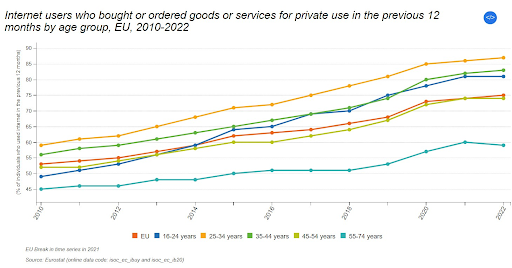Omnichannel Commerce – Combining Digital & Physical Retail

Omnichannel commerce is a marketing strategy embraced by many forward-thinking businesses that want to offer a supportive customer journey and reach customers where they’re at. Omni, meaning “all”, encompasses every type of sales channel, from brick-and-mortar stores to an ever-expanding list of digital platforms.
The use of multiple online channels, combined with an in-store presence, encourages customer loyalty by raising brand visibility and keeping potential customers interested. Omnichannel buyers enjoy a 360°customer experience, receiving multiple invitations to engage with your business. Because of the higher level of exposure, they may ultimately be more likely to follow your calls to action.
What Is Omnichannel Commerce?
An omnichannel shopping experience integrates online and offline channels that offer the customer different opportunities to purchase a product according to the media they use. The message companies send over different media channels will be carefully thought out and will appeal to the target audience that the business believes uses that particular mode of communication.
For example, a customer who adds an item to their cart but then abandons it may see an advertisement for that exact product while they’re browsing for something else on the internet. This isn’t a coincidence; this is part of an omnichannel marketing strategy that integrates various media channels to provide a seamless experience for the consumer. Similarly, customers who subscribe to a business’s email list and follow the brand on Twitter and Instagram will receive different content from the brand depending on which social networks they use.
In practice: A gourmet food company may use its newsletter to inform customers about a new line of products they have in-store or online. On the same company’s Twitter account, there may be a link providing a promo code for the new line, and on Instagram, there may be a recipe that features one of the products from the new line.
This is an example of how an omnichannel strategy works to engage customers from distinct demographics who may engage in differing ways with the brand. Many brands that use an omnichannel approach also have a physical store to maintain their high street presence and provide the personal attention many customers still prefer.
What Benefits Does Omnichannel Commerce Bring to a Business?

According to Eurostat, and as illustrated above, the percentage of consumers who bought products or services online “in the previous 12 months” has been rising year on year in every age group since 2010 when the study began. E-commerce and e-business are therefore important opportunities for physical shop owners to tap into. When combined with the power of social media, a business can potentially become much more visible using a multi-pronged approach.
When you embrace multiple channels, including a brick-and-mortar store, an e-commerce website and different sales channels on social media, it opens up your business to many different potential customers. These are just some of the benefits of adopting an omnichannel strategy:
- Ease of access for customers. Customers are becoming more and more likely to purchase online rather than in-store. Having multiple channels available means customers can engage with your content using the channel they prefer. Though online purchases are rising, many people still enjoy going to physical stores. Customers expect to have a wide range of options available to them and adopting an omnichannel approach allows you to satisfy that desire.
- More opportunities to purchase. Omnichannel retail gives customers more channels through which to make a purchase. Using a global payment gateway to facilitate different payment methods on different channels can open the door for customers from all around the world to place an order. Secure international payment gateways facilitate payments by credit card, debit card, digital wallets, bank transfer (…and more), and allow customers to pay in different currencies.
- Promotes customer loyalty. The use of customer data gained from studying their spending habits—including which sales channels they prefer, their average spend and the type of product they typically purchase, as well as data such as their email address—gives a business the chance to gain the customer’s loyalty through marketing campaigns and personalised offers. The business can also gauge the general level of customer satisfaction and create a more satisfying and personalised experience for customers.
- Certain merchant services—such as customer databases—allow your business to develop a more detailed breakdown of customer details, giving you a clear picture of who your customers are. This information can be used to focus resources and improve your return on investment.
Is Having a Brick-and-Mortar Store Still Worth It?
The advantages of multichannel commerce are clear. But is it worthwhile for digital businesses to invest in an in-store presence, or should they focus on digital channels and their online store? For omnichannel shoppers, there are some clear advantages to having a brick-and-mortar presence.
Physical Stores Are Important for “Deep” Product Purchases
Though it’s undeniable that many brands are reducing their high street presence, brands that were exclusively digital, such as Amazon and Alibaba, are opening physical stores. According to a study conducted by UC Berkeley in 2021, “a critical role of the physical store is to enhance customer value by providing physical engagement customers need to purchase “deep” products—products that require ample inspection in order for the customer to make an informed decision”.
The shortcomings of single-channel commerce for businesses that only utilise e-commerce are also noted in the study, explaining that many products require physical engagement. Products such as clothes, shoes, sofas and perfume simply can’t be sold as effectively online as in a physical high street store.
The Success of a Brick-and-Mortar Store May Depend on the Product You Sell
With a physical store being such a significant investment, it’s worth carefully analysing the benefits and potential downsides of opening a physical shop. For businesses that sell “deep” products or services that require customer contact, brick-and-mortar stores can still be worth it. Your store will then become an integral part of your omnichannel strategy.
Omnichannel commerce that embraces both online and offline retail can benefit from merchant services to keep track of cash and online purchases from all your sources of revenue. Payment processing also enables your physical shop to process credit card payments, enabling quick and convenient payments for your in-store customers.
How Is Omnichannel Commerce Different from Multichannel and Single-Channel Commerce?
Omnichannel commerce differs from the other two business models in the way that it engages with its customer base. The main difference doesn’t lie in how many channels a business uses, but in how the message they want to convey differs from channel to channel.
As we have already seen, an omnichannel approach engages customers in different ways using different channels. The message used on each channel, and how it is delivered, changes according to how the target audience responds to the content.
Multichannel Commerce
Multichannel commerce may use as many different channels as a business that embraces an omnichannel approach, but the message sent doesn’t typically differ between channels. Whereas an omnichannel marketing strategy that uses Instagram, Twitter and email to engage its followers would employ different marketing strategies for each channel, a multichannel strategy would use the same content in all three.
Many businesses find a multichannel strategy to be effective, and it’s typically a lot more cost-effective because fewer resources need to be invested in marketing. However, a multichannel approach tends to be a less personal and less unified experience than an omnichannel approach.
Single-Channel Commerce
Choosing to sell a product through just a single channel—whether digital or physical—is becoming less and less common. Examples of single-channel commerce could be having only a brick-and-mortar store or just an Instagram shop. Though single-channel commerce represents a somewhat old-fashioned business model, it may still offer advantages for some businesses:
- It can keep costs low. Single-channel businesses can be easily run by just one person.
- You can focus your efforts on perfecting that point of sale. If your resources are limited, it may be worth focusing all your energy on one strategy rather than overstretching yourself.
Omnichannel Commerce: A Modern Marketing Strategy that Covers All the Bases
Though omnichannel commerce isn’t the only viable marketing strategy, it is the one with the greatest potential for reaching and engaging new customers. By integrating in-store retail with an engaging digital marketing strategy, a business can appeal to a wide range of different customers that interact with your brand in different ways.
Brands that use an omnichannel approach can easily get complicated, with customers expecting to be able to make purchases using various payment methods and in different currencies. A merchant account for small businesses can help your business thrive, no matter how omnipresent—or focused—it is.
